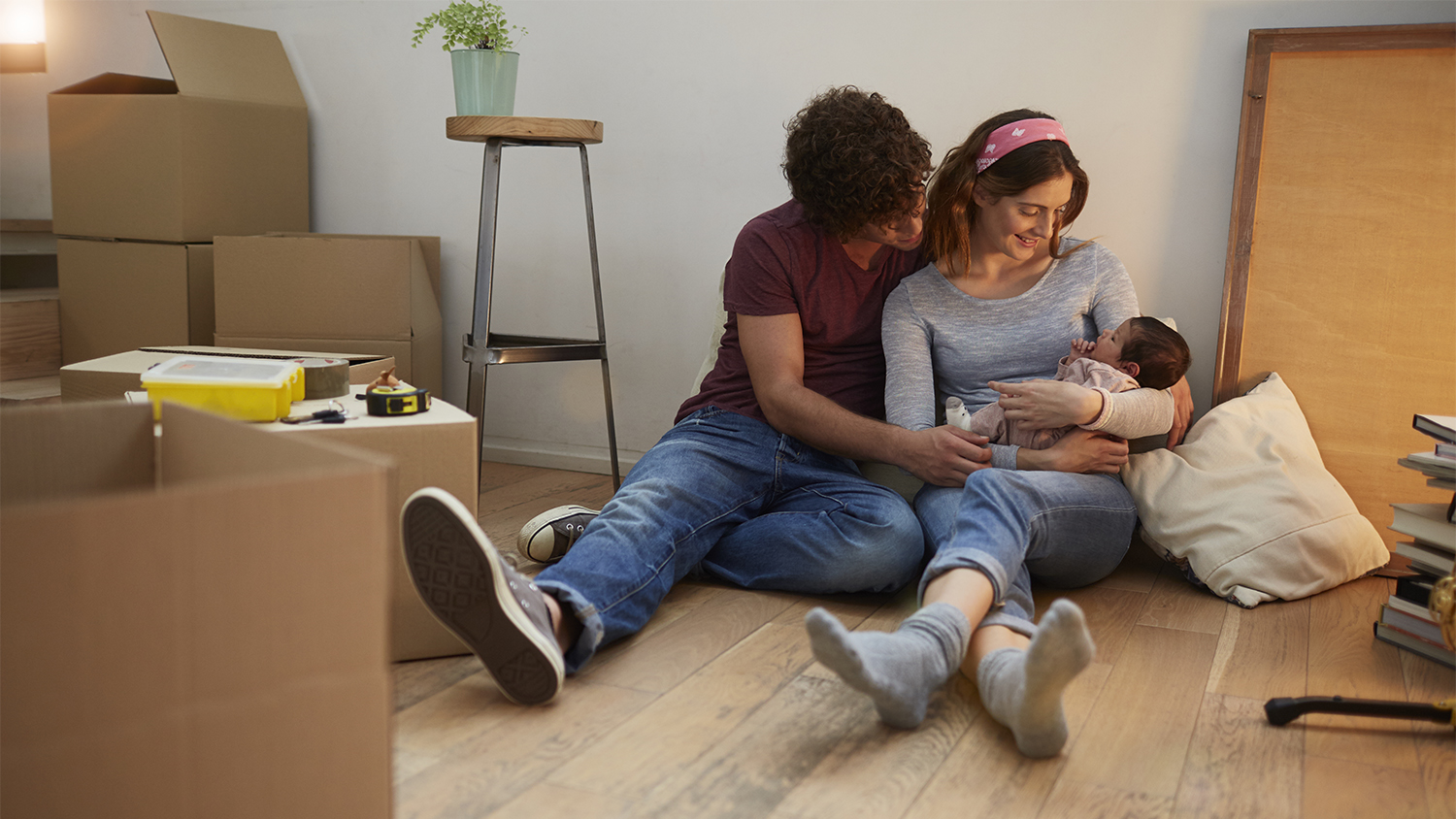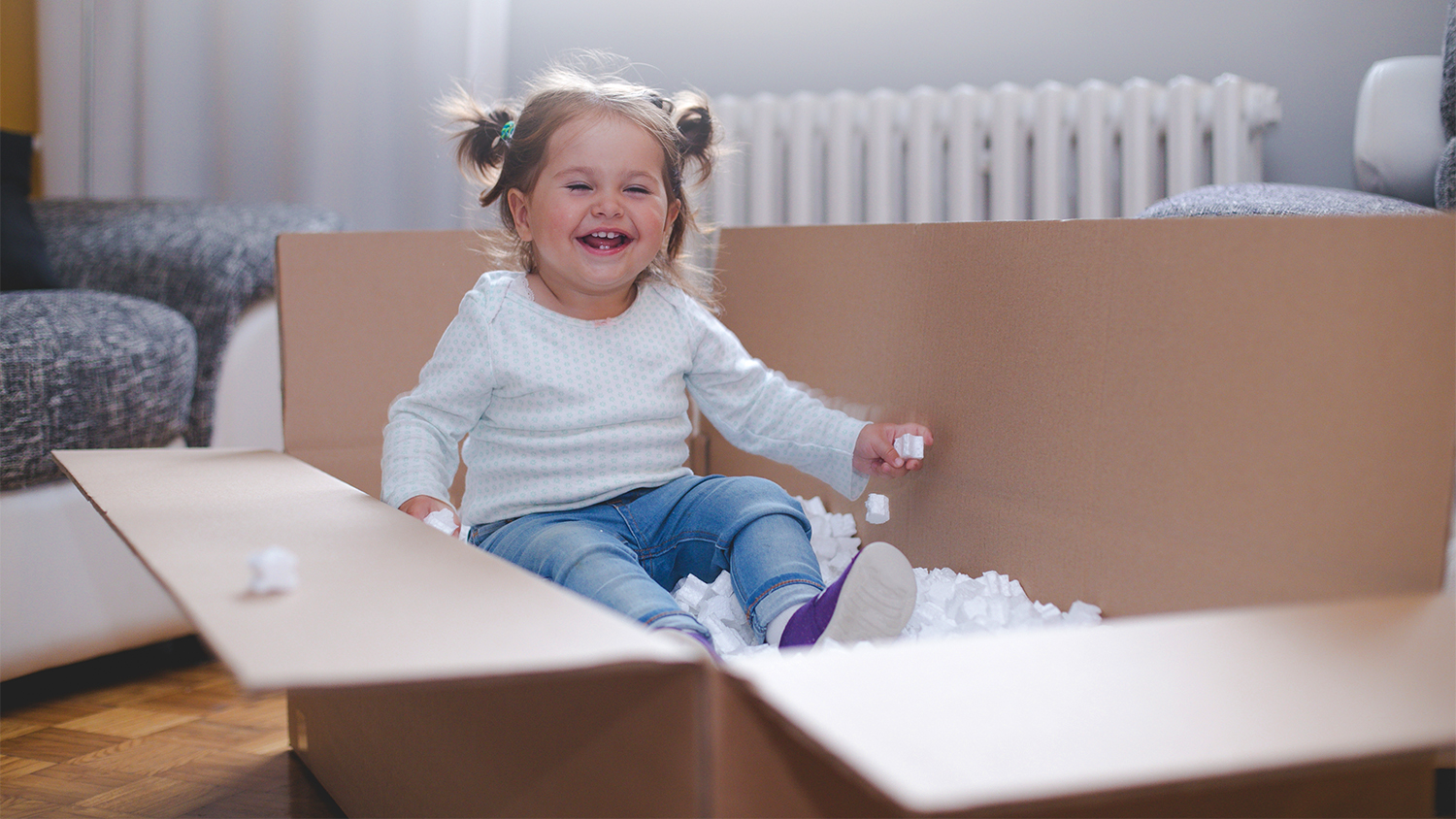10 Tips to Make Moving With a Baby a Breeze
Prep your home and family for a breezy moving day


Moving is never easy, and adding the stress of caring for little ones to the mix can be a recipe for disaster. But with the right plan in place, moving with babies and toddlers doesn’t have to be nerve-wracking. Use these nine tips to make your moving day a breeze—even with kids.
1. Handle Medical Needs First
Before you hit the road, schedule an appointment with your baby’s current pediatrician. Make sure they are up-to-date with every shot and routine test. This step will allow you some time to settle into your new home before another appointment is needed.
To get ahead of the game, consider finding a pediatrician in your new neighborhood before you arrive. You can ask your realtor for suggestions or join local neighborhood apps, like Nextdoor, to ask locals for recommendations as well.
2. Pick the Right Date
Use a calendar to plan and clearly mark the date of your move. Fall or winter are usually the cheapest times of the year to hire movers. For a DIY move, summer is usually the most convenient time to move while the kids are out of school.
Either way, putting it on your digital or physical calendar will show you exactly how much time you have between now and moving day. You can also mark days for packing certain rooms or areas of your home. Scheduling responsibilities will make packing more manageable and help you avoid last-minute moving stress.
3. Pack a Baby SOS Kit
The best way to make moving with babies and toddlers easier is to prepare for everything. We recommend making a moving emergency kit packed full of essential items you’ll need while on the road and at your new place, including:
Their favorite toy: Make sure you keep your child’s favorite toys within arms’ reach. It’s probably a good idea to pack more of these toys in your emergency stash than you think they’ll actually need.
Extra diaper bag items: Obviously, you’ll need to prep your diaper bag before moving. But you’ll also want to know where the extras are if (more like when) you need to restock. Pack a separate bag with extra diaper bag items that can be easily accessed when a refill is required.
Additional clothes: To avoid having to unpack all of your child’s clothes the minute you arrive, pack a separate suitcase full of outfits they can wear for the next few days. These are also handy in case there’s a spillage, leakage, or any other kid-related mess during the move.
Snacks and drinks: Keep food and drinks readily available. A cranky kid can make any situation more stressful, and “hangry” parents only add to that. Take care of both you and your child by having snacks on hand, and don’t forget to stay hydrated.
Cleaning supplies: Pack a box of easily accessible cleaning supplies. That way, you can quickly clean an area in the new house for your little one to lay, roll, crawl, or walk.
When you arrive at your new home, bring these boxes out first. This method will help build a comfortable and recognizable space for your kids to hang out while you finish your work.
4. Don’t Mess with Your New Baby’s Routine

Any new parent knows the importance of a baby’s schedule. From wake windows to feedings to everything in between, routine is one of the best (maybe only) ways to stay sane during those first few months.
When planning your move, ensure you design your schedule to help maintain a consistent routine for your baby. Not only will this help make sure that your baby or toddler stays as happy as possible, but it also will allow your day to run as smoothly. That will make for a happy parent, too.
For example, if your baby has a three-hour wake window, use that time to load boxes, drive to your new home, unload your vehicle. Then, when it’s nap time, find a quiet and dark place where your kids can take a snooze while you focus on unpacking boxes. Better yet—use that time to take a break of your own.
5. Prep Your Child as Much as Possible

Moving day shouldn’t come as a surprise to your kids. Talk about the move and share positive things about your new house as early and as often as possible. This tactic will give them ample time to adjust and even get excited about the idea.
If you’re moving away from friends and family and have an older child, throw a goodbye party or help them create a plan with loved ones on how and when they’ll see them next.
For younger kids, you’ll also want to get them used to the physical chaos that is moving. Allowing small children to play with safe moving materials, like bubble wrap, provides a fun sensory experience while also preparing them for the move.
6. Bookmark Your First Rest Stop
Whether your new home is down the street or across the country, every parent knows they’re going to need to make a pit stop on the way. Plan ahead by locating family-friendly restaurants, rest stops, or open parks along the way and saving the address in your itinerary.
Even if your kids don’t have to use the restroom or need a snack, you should plan to stop every two hours, according to the two-hour rule. This rule urges parents to limit time in a car seat to two hours, as it can put pressure on the developing spine and restrict airflow to the lungs.
7. Take Extra Safety Precautions
Is it safe to move with a newborn? Absolutely—with the right preparation.
The moving process is full of risks, like tripping or falling. To keep your small children away from danger, create a safe space for your child during the move. Set up these items to keep your child safe during the loading and unloading process.
Playpen: Set up a playpen and place their favorite toys in it to keep them out of harm’s way.
Baby gate: Install a baby gate in the doorway so your little one can’t wander around their new house.
Different carrying aids: If your baby is too small for a playpen, try baby-wearing instead. This method can be especially helpful when unpacking.
8. Remain Calm During the Move
Even with all of these moving tips, it will likely still be stressful. Stay calm during your move by ensuring that you have a few last-ditch efforts ready when you sense an incoming meltdown.
Download a few shows to your fully-charged iPad or let your kid create a playlist full of their favorite songs. You can even ask your realtor for close-by parks or walking trails so you can take an outdoor break when needed. Do whatever you need to do to keep everyone cool, calm, and collected throughout the day—yourself included.
9. Consider Hiring a Babysitter
Do these steps feel like too much of a strain on your mental health? In that case, consider hiring a babysitter.
Whether you have family members or friends who can help or need to hire a babysitter, have someone watch your kids on moving day, and even on the days leading up to the move, so you have uninterrupted time to get the job done. Remember: Many people would likely rather watch your baby than help you pack up and move.
10. Take Your Time Unpacking
Allow yourself time to unpack. Understand that you have a young child who demands a lot of your time, and it’s perfectly acceptable to take a few days (or weeks) to get everything out of boxes.
However, you should prioritize setting up your kid’s room first. Setting their room up quickly will help them feel more comfortable and settle in faster, giving you the freedom to finish the unpacking process at a pace that works for you.





- The Ultimate Moving Out Checklist: 8 Week Countdown
- 45-Point Moving Cross-Country Checklist
- 20 Moving Tips to Help You Prepare for Moving Day
- How to Move By Yourself: 10 Top Tips
- 8 Tips to Consider When Planning Your Move Date
- How To Prepare for Movers: 17 Essential Tips
- Should You Ask Your Friends to Help You Move?
- Which Home Projects To Put On Your To-Do List First After Moving
- How to Move Out of State: A Complete Guide
- 7 Creative Ways to Save Money When Moving















